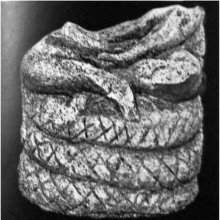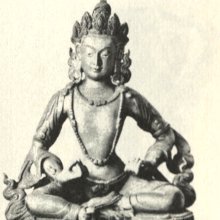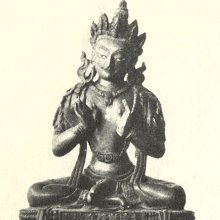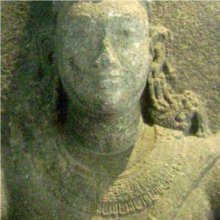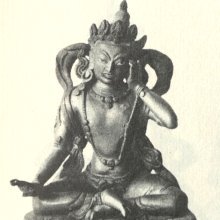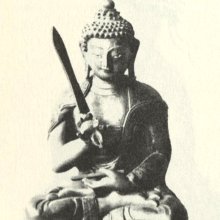U: 15 definitions
Introduction:
U means something in Hinduism, Sanskrit, the history of ancient India, Marathi, Hindi, Tamil. If you want to know the exact meaning, history, etymology or English translation of this term then check out the descriptions on this page. Add your comment or reference to a book if you want to contribute to this summary article.
Alternative spellings of this word include Oo.
Images (photo gallery)
(+1115 more images available)
In Hinduism
Vyakarana (Sanskrit grammar)
Source: Wikisource: A dictionary of Sanskrit grammarU (उ).—(l) labial vowel standing for the long ऊ (ū) and protracted ऊ3 in Pāṇini's grammar unless the consonant त् (t) is affixed to it, उत् (ut) standing for the short उ (u) only: (2) Vikaraṇa affix उ (u) of the 8th conjugation (तनादिगण (tanādigaṇa)) and the roots धिन्व् (dhinv) and कृण्व् (kṛṇv);cf.P.III. 1.79-80; (3) substitute (उ) for the vowel अ (a) of कृ (kṛ),e.g. कुरुतः, कृर्वन्ति (kurutaḥ, kṛrvanti) before weak Sārvadhātuka affixes, cf.P.VI 4.110; (4) kṛt. affix उ (u) added to bases ending in सन् (san) and the roots आशंस्, भिक्ष्, विद्, इष् (āśaṃs, bhikṣ, vid, iṣ) as also to bases ending in क्यच् (kyac) in the Vedic Literature,e.g. चिकीर्षुः भिक्षुः, बिन्दुः,इच्छुः,सुम्नयु (cikīrṣuḥ bhikṣuḥ, binduḥ, icchuḥ, sumnayu); cf. P. III. 2.168-170; (5) Uṅādi affix उ (u) (उण् (uṇ)) e.g, कारुः, वायुः, साधुः (kāruḥ, vāyuḥ, sādhuḥ), etc.; cf. Uṅādi I.1; (6) mute vowel उ (u) added to the first letters of a class of consonants in Pāṇini's grammar to show the whole class of the five letters; e.g. कु, चु, टु, तु, पु (ku, cu, ṭu, tu, pu) which stand for the Guttural, the palatal the lingual, the dental and the labial classes respectively; cf. also ष्टुना ष्टुः (ṣṭunā ṣṭuḥ) P.VIII.4.41(7) उ (u) added to न् (n) showing the consonant न् (n) as nasalized n; cf, नुः (nuḥ) V.Pr. III.133.
--- OR ---
Ū (ऊ).—Long vowel ऊ, उ (ū, u) being the short vowel.

Vyakarana (व्याकरण, vyākaraṇa) refers to Sanskrit grammar and represents one of the six additional sciences (vedanga) to be studied along with the Vedas. Vyakarana concerns itself with the rules of Sanskrit grammar and linguistic analysis in order to establish the correct context of words and sentences.
Purana and Itihasa (epic history)
Source: archive.org: Puranic Encyclopedia1) U (उ).—The letter 'u' means Śiva. (Agni Purāṇa, Chapter 348).
2) Ū (ऊ).—This letter means 'protection'. (Agni Purāṇa, Chapter 348).

The Purana (पुराण, purāṇas) refers to Sanskrit literature preserving ancient India’s vast cultural history, including historical legends, religious ceremonies, various arts and sciences. The eighteen mahapuranas total over 400,000 shlokas (metrical couplets) and date to at least several centuries BCE.
India history and geography
Source: Cologne Digital Sanskrit Dictionaries: Indian Epigraphical GlossaryU.—(IE 8-1), abbreviation of the land measure called udāna (q. v.). Note: u is defined in the “Indian epigraphical glossary” as it can be found on ancient inscriptions commonly written in Sanskrit, Prakrit or Dravidian languages.

The history of India traces the identification of countries, villages, towns and other regions of India, as well as mythology, zoology, royal dynasties, rulers, tribes, local festivities and traditions and regional languages. Ancient India enjoyed religious freedom and encourages the path of Dharma, a concept common to Buddhism, Hinduism, and Jainism.
Languages of India and abroad
Marathi-English dictionary
Source: DDSA: The Molesworth Marathi and English Dictionaryu (उ).—
--- OR ---
u (उ).—The fifth vowel; corresponding with u in full, and here represented by U. 2 (ud or ut S) An inseparable particle and prefix to verbs, implying contrariety of action, privation, deterioration &c.: as usaviṇēṃ, upikaṇēṃ, ulagaḍaṇēṃ, ucakaṭaṇēṃ, upiṭhaṇēṃ, uvaḷaṇēṃ.
--- OR ---
ū (ऊ).—
--- OR ---
ū (ऊ).—The sixth vowel. It corresponds with U in Rule, and is here represented by U'.
--- OR ---
ū (ऊ).—f (yūkā S) A louse. The plural is uvā shortened into vā.
Source: DDSA: The Aryabhusan school dictionary, Marathi-Englishu (उ).—The fifth vowel.
--- OR ---
u (उ).—f A louse. uilā a Lousy.
--- OR ---
ū (ऊ).—The sixth vowel. f A louse.
--- OR ---
ū (ऊ).—interj How? Eh? What? f A louse.
Marathi is an Indo-European language having over 70 million native speakers people in (predominantly) Maharashtra India. Marathi, like many other Indo-Aryan languages, evolved from early forms of Prakrit, which itself is a subset of Sanskrit, one of the most ancient languages of the world.
Sanskrit dictionary
Source: DDSA: The practical Sanskrit-English dictionaryU (उ).—I. 1 Ā. (avate, ūve, auṣṭa, otum, uta)
1) To sound, make a noise.
2) To roar, bellow (as a bull &c.). -II 5 P. (unoti) Ved. To ask, demand.
--- OR ---
U (उ).—1 Name of Śiva, the second of the three syllables in ओम् (om); see अ (a).
2) Name of Brahmā.
3) The orb of the moon; cf. also उर्गौरीपतिरुः कालः सेतुर्नाथः परायणः । नारदोऽर्कोऽनिलः पाशी मार्कण्डेयोऽथ रावणः (urgaurīpatiruḥ kālaḥ seturnāthaḥ parāyaṇaḥ | nārado'rko'nilaḥ pāśī mārkaṇḍeyo'tha rāvaṇaḥ) || Ek. -ind.
1) As a particle used expletively; उ उमेशः (u umeśaḥ) Sk.
2) An interjection of :-(a) calling; उ मेति मात्रा तपसो निषिद्धा पश्चादुमाख्यां सुमुखी जगाम (u meti mātrā tapaso niṣiddhā paścādumākhyāṃ sumukhī jagāma) Kumārasambhava 1.26; (b) anger; (c) compassion; (d) command; (e) acceptance; (f) interrogation; उ मेति मात्रा तपसो निषिद्धा (u meti mātrā tapaso niṣiddhā) Kumārasambhava 1.26. (g) wonder; यत्सन्निधावहमु खाण्डवमग्नयेऽदाम् (yatsannidhāvahamu khāṇḍavamagnaye'dām) Bhāgavata 1.15.8. or used merely as an expletive. In the Veda used as an enclitic copula implying restriction and emphasis (and, but, on the other hand, now, I ask &c.); in classical literature used chiefly with अथ (atha) (atho), न (na) (no) and किम् (kim) (kimu); see these words. उ-उ (u-u) or उत (uta) on the one hand-on the other hand, partly-partly.
Derivable forms: uḥ (उः).
--- OR ---
Ū (ऊ).—[avatīti, ava-kvip ūṭh]
1) Name of Śiva.
2) The moon.
3) A protector; cf. ऊः परेतोऽण्डजस्त्वष्टा विवस्वानग्निसारथिः । वह्निर्निशाकरः पूर्णो दरिद्री सरमा- धिपः (ūḥ pareto'ṇḍajastvaṣṭā vivasvānagnisārathiḥ | vahnirniśākaraḥ pūrṇo daridrī saramā- dhipaḥ) || Ek. -ind.
1) A particle used to introduce a subject.
2) An interjection of (a) calling; (b) of compassion; (c) protection.
Derivable forms: ūḥ (ऊः).
Source: Cologne Digital Sanskrit Dictionaries: Shabda-Sagara Sanskrit-English DictionaryU (उ).—The third short vowel of the Sanskrit alphabet, corresponding to the letter U, and pronounced as that is in the word full.
--- OR ---
U (उ).—r. 1st cl. (ṅa) uṅ (uvate) To sound, to make a particular sound or noise.
--- OR ---
U (उ).—ind. An interjection, 1. of assent; 2. of calling; 3. of compassion; 4. anger; and 5. of command. 6. An expletive. m.
(-uḥ) 1. A name of Siva. 2. Of Brahma.
--- OR ---
Ū (ऊ).—The sixth vowel of the Sanskrit alphabet, corresponding to U long, and having the sound of that letter in the word rule.
--- OR ---
Ū (ऊ).—ind. 1. An incipient particle. 2. An interjection of compassion. 3. Of regard. m. (ūḥ) The moon. E. av to go, kvip affix, va becomes ū.
Source: Cologne Digital Sanskrit Dictionaries: Benfey Sanskrit-English DictionaryU (उ).—I. interj. of anger, of command, [Kumārasaṃbhava, (ed. Stenzler.)] 1, 26. Ii. a part. (cf. ud), 1. Also. 2. Now,
— Cf. atho under atha, kim, and the ved. combination sa u, with in
--- OR ---
U (उ).—i. 1, [Ātmanepada.] To sound.
--- OR ---
Ū (ऊ).—see u.
Source: Cologne Digital Sanskrit Dictionaries: Cappeller Sanskrit-English DictionaryU (उ).—1. interj.
--- OR ---
U (उ).—2. ([enclitic]) and, also, yet, now, soon, again; lays stress on a [preceding] [pronoun], particle or infin. in tavai (tavā u); u ṣu ( = su) right soon, mo ( = māu) ṣu never. u-u (or uta) on the one hand-on the other hand, as well-as.
--- OR ---
Ū (ऊ).—([enclitic]) and, also, yet, now, soon, again; lays stress on a [preceding] [pronoun], particle or infin. in tavai (tavā u); u ṣu ( = su) right soon, mo ( = māu) ṣu never. u-u (or uta) on the one hand-on the other hand, as well-as.
--- OR ---
U (उ).—3. unoti proclaim.
--- OR ---
Ū (ऊ).—& ū = 2 u.
Source: Cologne Digital Sanskrit Dictionaries: Monier-Williams Sanskrit-English Dictionary1) U (उ):—1. u the fifth letter and third short vowel of the alphabet, pronounced as the u in full.
2) 2. u ind. an interjection of compassion, anger, [cf. Lexicographers, esp. such as amarasiṃha, halāyudha, hemacandra, etc.]
3) a particle implying assent, calling, command, [cf. Lexicographers, esp. such as amarasiṃha, halāyudha, hemacandra, etc.]
4) 3. u ind. an enclitic copula used frequently in the Vedas;
5) (as a particle implying restriction and antithesis, generally after pronominals, prepositions, particles, and before nu and su, equivalent to) and, also, further; on the other hand (especially in connexion with a relative e.g. ya u, he on the contrary who etc.)
6) This particle may serve to give emphasis, like id and eva, especially after prepositions or demonstrative pronouns, in conjunction with nu, vai, hi, cid, etc. (e.g. ayam u vām purutamo... johavīti [Ṛg-veda iii, 62, 2], this very person [your worshipper] invokes you etc.) It is especially used in the figure of speech called Anaphora, and particularly when the pronouns are repeated (e.g. tam u stuṣa indram tam gṛṇīṣe [Ṛg-veda ii, 20, 4], him I praise, Indra, him I sing). It may be used in drawing a conclusion, like the English ‘now’ (e.g. tad u tathā na kuryāt [Śatapatha-brāhmaṇa v, 2, 2, 3], that now he should not do in such a manner), and is frequently found in interrogative sentences (e.g. ka u tac ciketa [Ṛg-veda i, 164, 48], who, I ask, should know that?)
7) Pāṇini calls this particle uñ to distinguish it from the interrogative u. In the Pada-pāṭha it is written ūm.
8) In the classical language u occurs only after atha, na, and kim, with a slight modification of the sense, and often only as an expletive (See kim);
9) — u or u — uta, on the one hand on the other hand; partly — partly; as well — as.
10) 4. u [class] 5. [Parasmaipada] unoti (See vy-u, [Ṛg-veda v, 31, 1]) : [class] 2. [Ātmanepada] (1. sg. uve, [Ṛg-veda x, 86, 7]) : [class] 1. [Ātmanepada] avate, [Dhātupāṭha];
—to call to, hail;
—to roar, bellow (See also ota = ā-uta).
11) 5. u m. Name of Śiva
12) also of Brahman, [cf. Lexicographers, esp. such as amarasiṃha, halāyudha, hemacandra, etc.]
13) Ū (ऊ):—1. ū the sixth letter of the alphabet (corresponding to u long, and having the sound of that letter in the word rule).
14) 2. ū ind. an interjection of calling to
15) of compassion
16) a particle implying promise to protect, [cf. Lexicographers, esp. such as amarasiṃha, halāyudha, hemacandra, etc.]
17) a particle used at the beginning of a sentence.
18) 3. ū mfn. (√av, [Pāṇini 6-4, 20]), helping, protecting, [cf. Lexicographers, esp. such as amarasiṃha, halāyudha, hemacandra, etc.]
19) m. (ūs) the moon, [cf. Lexicographers, esp. such as amarasiṃha, halāyudha, hemacandra, etc.]
20) Name of Śiva, [cf. Lexicographers, esp. such as amarasiṃha, halāyudha, hemacandra, etc.]
21) 4. ū mfn. (√ve, [Vopadeva xxvi, 73]), weaving, sewing.
Source: Cologne Digital Sanskrit Dictionaries: Yates Sanskrit-English Dictionary1) U (उ):—The fifth vowel or u, as in the word pull.
2) (ṅa) avate 1. d. To sound.
3) interj. Oh! m. (uḥ) Shiva.
4) Ū (ऊ):—The sixth vowel of the Sanscrit alphabet, ū long.
5) ind. An incipient particle.
6) (ūḥ) 3. m. The moon.
[Sanskrit to German]
Sanskrit, also spelled संस्कृतम् (saṃskṛtam), is an ancient language of India commonly seen as the grandmother of the Indo-European language family (even English!). Closely allied with Prakrit and Pali, Sanskrit is more exhaustive in both grammar and terms and has the most extensive collection of literature in the world, greatly surpassing its sister-languages Greek and Latin.
Hindi dictionary
Source: DDSA: A practical Hindi-English dictionary1) U (उ):——the fifth letter and the fifth vowel of the Devnagri: alphabet.
2) Ū (ऊ) [Also spelled oo]:——the sixth vowel and the sixth letter of the Devnagri: alphabet.
...
Kannada-English dictionary
Source: Alar: Kannada-English corpusU (ಉ):—
1) [noun] the fifth letter and the fifth vowel of Kannaḍa alphabet, when joined with a consonant gives the sound grossly equal to that of short 'ಉ' (as in the word "put" ) of English.
2) [noun] the second of the three syllables that make the sacred compound-syllable ' ಓಂ [om] '.
--- OR ---
U (ಉ):—[interjection] an interjection expressing abhorrence, disgust.
--- OR ---
Ū (ಊ):—[noun] the sixth letter and the sixth vowel of Kannaḍa alphabet.
--- OR ---
Ū (ಊ):—[interjection] an interjection expressing pain or disapproval; (in this sense, this is pronounced usu. with a nasal sound).
Kannada is a Dravidian language (as opposed to the Indo-European language family) mainly spoken in the southwestern region of India.
See also (Relevant definitions)
Starts with (+9980): Durniti, Durnitikara, Hog urine, U chawjc chifu, U pa la we da, U sa ka, U tpa la dkar po, U tpa la snon po, U tpa la snos po, U-bet, U-chan, U-hawai, U-luo, U-muum, U-rgyan, U-soh-lyn-shang, U-takhellei, U-tu-it, U-vai, Ua.
Ends with (+9980): A ga ru, A la bo jiao shu, A-aphu, A-karaipatuttu, A-potaikkappotu, A-puccikattu, A-varuku, Aa-aafu, Aachalu, Aachedimbada baeru, Aachhuaachhu, Aad-rahanu, Aadalodaka veru, Aadalu haralu, Aadambu, Aadavipogaku, Aadithyalu, Aadu, Aadumuttadasoppu, Aagrah-garnu.
Full-text (+10296): Um, Ukara, Titau, Durhanu, Uvarna, Tanc, Klish, Smrito, Strih, Uh, Ubhava, Ananyakarya, Ekavama, Pragrihya, Guh, Usuyya, Varatanu, Ashamsu, Yathajatam, Durbalita.
Relevant text
One of your search terms exceeds the minimun character amount per search term. This amount currently equals 2.
No search results for U, Ū in any book or story.
Related products
(+15 more products available)
